Battery Citroen C ZERO RHD 2017 1.G Owner's Guide
[x] Cancel search | Manufacturer: CITROEN, Model Year: 2017, Model line: C ZERO RHD, Model: Citroen C ZERO RHD 2017 1.GPages: 174, PDF Size: 4.16 MB
Page 107 of 174

105
F Check that the charging warning lamp in the instrument panel is
on fixed.
Fast charging stops automatically
when the main battery is around 80%
charged. It is possible to attain a charge
of 100% by restarting the procedure.
However, the time taken by this
additional charge will be relatively long,
as the charging rate is reduced. During fast charging, the vehicle's air
conditioning may start automatically,
if needed to cool the main battery. It is
therefore per fectly normal to hear the
noise of a fan running from outside the
vehicle and to see a puddle of water
form under the vehicle. As a safety measure, the motor will
not start when the charging cable is
connected to the vehicle's socket.
Also, any attempt to start the motor
interrupts the charging procedure. It
will then be necessary to disconnect
and reconnect the charging cable to
the vehicle's socket, then to restart the
charging following the instructions for
using the charging station.If the exterior temperature is
below
0 °C, the charging time may be
longer.
If the exterior temperature is
below
-25 °C, charging may not be
possible.
If this is not the case, charging has not started;
check the operating instructions for the
charging station. The charging warning lamp in the instrument
panel goes off when charging is complete.
F
D
isconnect the charging cable following
the instructions for the charging terminal.
F
C
lose the charging socket cover and
the
flap.
After charging, close the charging
socket cover and flap.
Take care to avoid the ingress of water
or dust into the socket, under its cover
or into the charging plug. Risk of fire or
electrocution.
Vehicle out of use for a long
period
When your vehicle is going to be out
of use for a long period, charge the
main battery completely every three
months (following the normal charging
procedure).
Before charging, check that the
12 V battery is not disconnected or
discharged. If this is the case, refer
to the "12 V battery" section for
reconnecting or charging the battery.
7
Practical information
Page 108 of 174
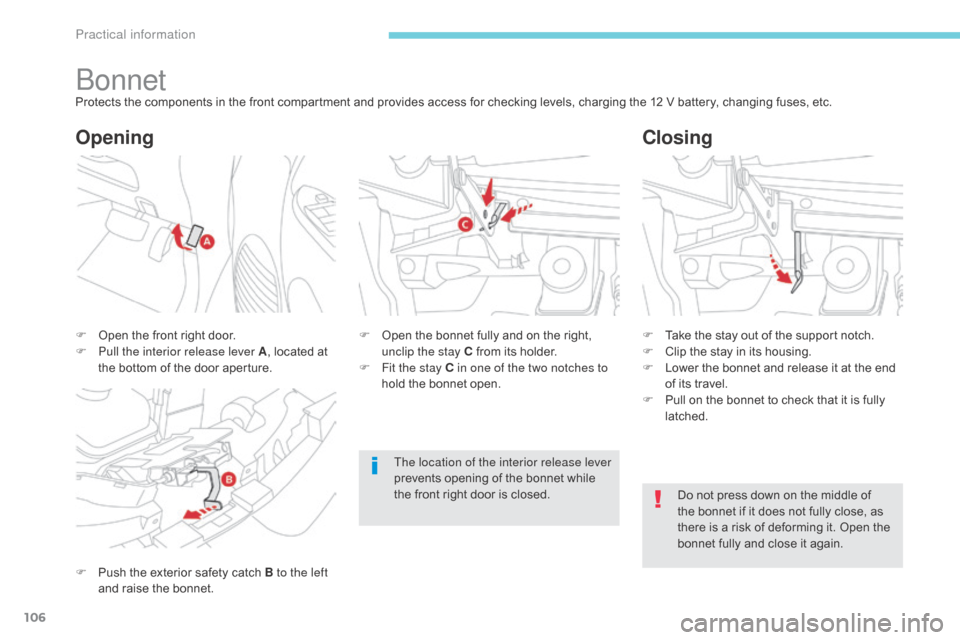
106
BonnetProtects the components in the front compartment and provides access for checking levels, charging the 12 V battery, changing fuses, etc.
F
P
ush the exterior safety catch B to the left
and raise the bonnet. F
O
pen the bonnet fully and on the right,
unclip the stay C from its holder.
F
F
it the stay C in one of the two notches to
hold the bonnet open.
F
O
pen the front right door.
F
P
ull the interior release lever A , located at
the bottom of the door aperture.
Opening Closing
F Take the stay out of the support notch.
F
C lip the stay in its housing.
F
L
ower the bonnet and release it at the end
of its travel.
F
P
ull on the bonnet to check that it is fully
latched.
Do not press down on the middle of
the bonnet if it does not fully close, as
there is a risk of deforming it. Open the
bonnet fully and close it again.
The location of the interior release lever
prevents opening of the bonnet while
the front right door is closed.
Practical information
Page 109 of 174
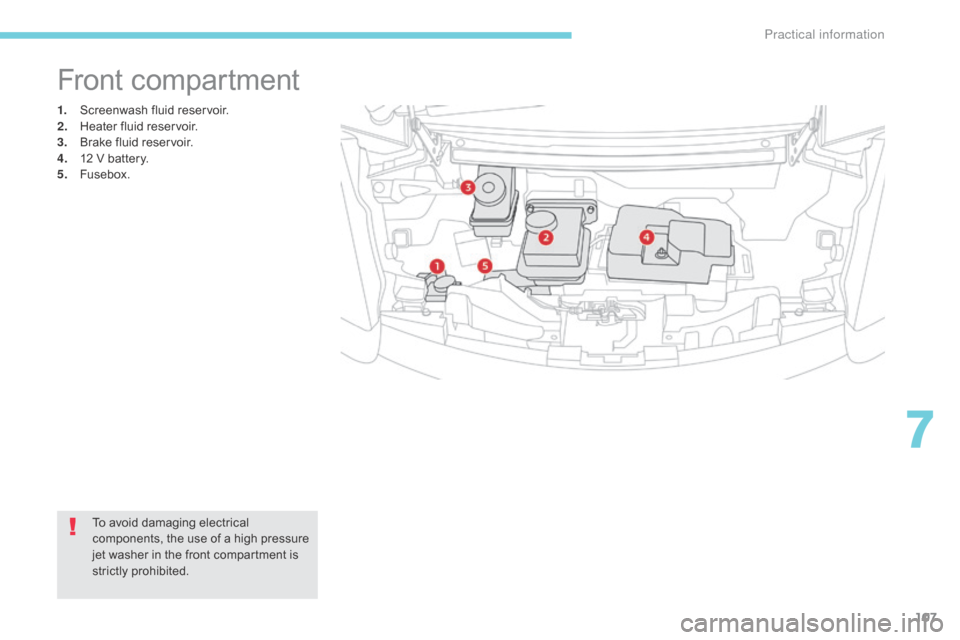
107
1. Screenwash fluid reservoir.
2. Heater fluid reservoir.
3.
B
rake fluid reservoir.
4.
1
2 V battery.
5.
F
usebox.
Front compartment
To avoid damaging electrical
components, the use of a high pressure
jet washer in the front compartment is
strictly prohibited.
7
Practical information
Page 112 of 174

110
The coolant level should be between
the MIN "L" and MA X "F" marks.
Coolant levelAvoid prolonged contact of used fluids
with the skin.
Most of these fluids are harmful to
health and some are very corrosive.
Do not discard used fluids into sewers
or onto the ground.
Take used fluids to a CITROËN dealer
or a qualified workshop (France) or to
an authorised waste disposal site.
Used products
Rear compartment
Changing the coolant
The coolant does not have to be changed.
Coolant specification
The coolant must conform to the
manufacturer's recommendations. As the cooling system is pressurised, wait at
least one hour after switching off the motor
and/or the end of the charging cycle before
carrying out any work.
To avoid any risk of scalding, unscrew the cap
by two turns to allow the pressure to drop.
When the pressure has dropped, remove the
cap and top up the level.
12 V battery electrolyte
level
Remove the battery protective cover to check
this level.
For more information on the 12 V battery, refer
to the corresponding section.
The level of this fluid should be between the
MIN "LOWER LEVEL" and MA X "UPPER
LEVEL" marks.
If necessary, top up using distilled water by
removing the caps of the different battery
compartments.
Check the electrolyte level at least once
per month.
Practical information
Page 114 of 174

112
Changing a wiper
blade
Removing a front or rear
wiper blade
F Raise the corresponding wiper arm.
F R emove the wiper blade, sliding it towards
the outside.
Fitting a front or rear wiper
blade
F Put the new wiper blade in place and secure it.
F
F
old down the wiper arm carefully.
Precautions for
washing
To avoid damaging the electrical
components, the use of a high pressure
jet wash is strictly prohibited:
-
i
n the front compartment (under the
bonnet).
-
u
nder the body.
For washing the bodywork, do not use a
pressure greater than 80 bars. Check - before washing the vehicle -
that the charging flaps and the charging
socket covers (normal and fast charge)
are properly closed. Do not wash the vehicle while the
battery is being recharged.
Practical information
Page 115 of 174
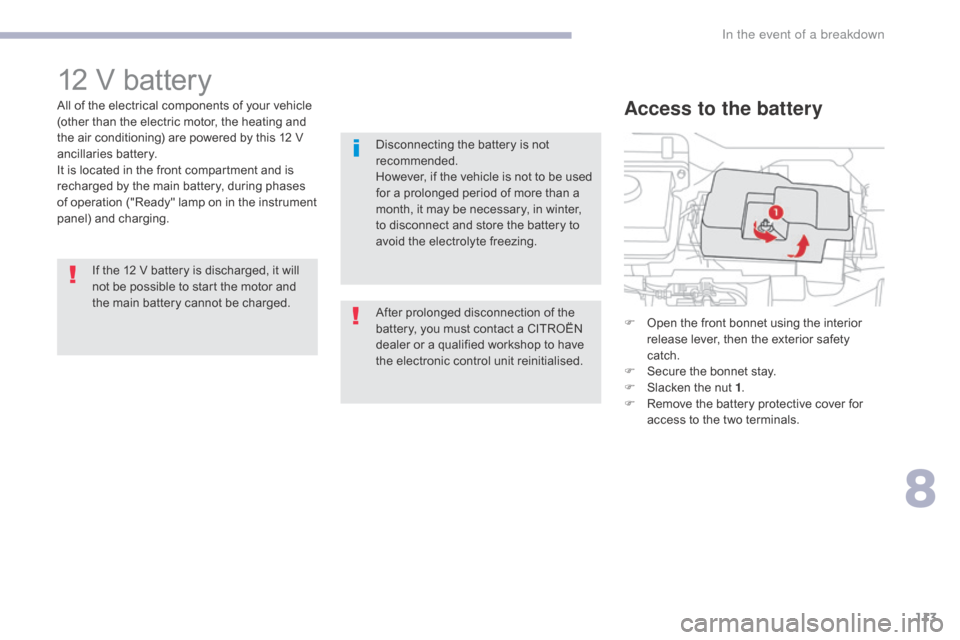
113
12 V battery
All of the electrical components of your vehicle
(other than the electric motor, the heating and
the air conditioning) are powered by this 12 V
ancillaries battery.
It is located in the front compartment and is
recharged by the main battery, during phases
of operation ("Ready" lamp on in the instrument
panel) and charging.If the 12 V battery is discharged, it will
not be possible to start the motor and
the main battery cannot be charged. F
O
pen the front bonnet using the interior
release lever, then the exterior safety
catch.
F
S
ecure the bonnet stay.
F
S
lacken the nut 1.
F
R
emove the battery protective cover for
access to the two terminals.Access to the battery
Disconnecting the battery is not
recommended.
However, if the vehicle is not to be used
for a prolonged period of more than a
month, it may be necessary, in winter,
to disconnect and store the battery to
avoid the electrolyte freezing.
After prolonged disconnection of the
battery, you must contact a CITROËN
dealer or a qualified workshop to have
the electronic control unit reinitialised.
8
In the event of a breakdown
Page 116 of 174
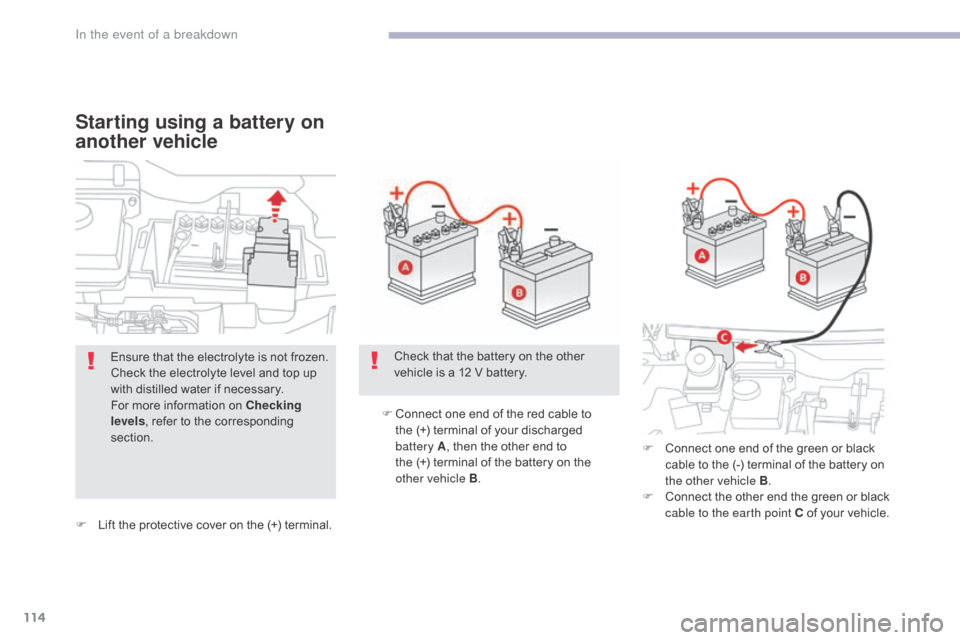
114
F Lift the protective cover on the (+) terminal.F
C
onnect one end of the red cable to
the (+) terminal of your discharged
battery A , then the other end to
the (+) terminal of the battery on the
other vehicle B .
Starting using a battery on
another vehicle
F Connect one end of the green or black
cable to the (-) terminal of the battery on
the other vehicle B .
F
C
onnect the other end the green or black
cable to the earth point C of your vehicle.
Ensure that the electrolyte is not frozen.
Check the electrolyte level and top up
with distilled water if necessary.
For more information on Checking
levels
, refer to the corresponding
section. Check that the battery on the other
vehicle is a 12 V battery.
In the event of a breakdown
Page 117 of 174

115
Charging the battery using
a battery charger
F Start the other vehicle and wait a few m inutes.
F
T
urn the ignition key on your vehicle, until
the "Ready" lamp comes on.
F
D
isconnect the cables in the reverse order.
F
R
efit the battery protective cover and
tighten the fixing screw.
If the "Ready" lamp does not come on, proceed
as follows:
F
L
eave the cables connected.
F
R
eturn the ignition switch on your vehicle
to the " LOCK" position.
F
P
ut the main battery on charge, following
the procedure for normal charging.
F
W
hen the charging warning lamp in
the instrument panel comes on fixed,
disconnect the cables.
F
L
eave the battery on charge for at least
one hour.
F
T
urn the ignition key on your vehicle, until
the "Ready" lamp comes on.
If the problem persists, contact a
CITROËN
dealer or a qualified workshop. F
R emove the protective cover from the
battery.
Ensure that the electrolyte is not frozen.
Check the electrolyte level and top up
with distilled water if necessary.
For more information on Checking
levels , refer to the corresponding
section. F
S
lacken the nut 1 and lift off the
retaining
ba
r.
8
In the event of a breakdown
Page 118 of 174
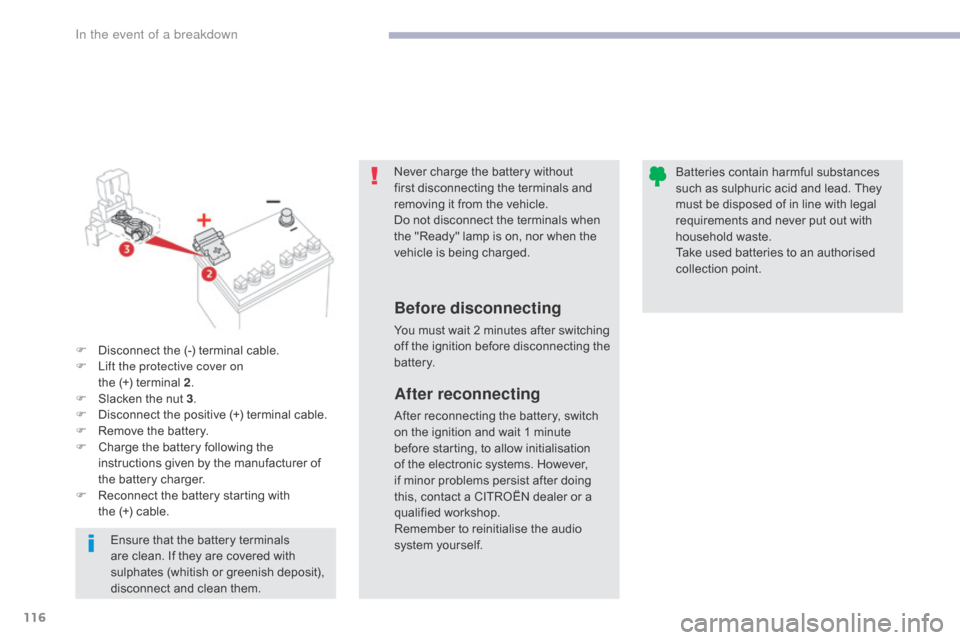
116
Never charge the battery without
first disconnecting the terminals and
removing it from the vehicle.
Do not disconnect the terminals when
the "Ready" lamp is on, nor when the
vehicle is being charged.
Before disconnecting
You must wait 2 minutes after switching
off the ignition before disconnecting the
battery.Batteries contain harmful substances
such as sulphuric acid and lead. They
must be disposed of in line with legal
requirements and never put out with
household waste.
Take used batteries to an authorised
collection point.
F
D
isconnect the (-) terminal cable.
F
L
ift the protective cover on
the
(+)
terminal
2 .
F
S
lacken the nut 3 .
F
D
isconnect the positive (+) terminal cable.
F
R
emove the battery.
F
C
harge the battery following the
instructions given by the manufacturer of
the battery charger.
F
R
econnect the battery starting with
the
(+)
cable.
After reconnecting
After reconnecting the battery, switch
on the ignition and wait 1 minute
before starting, to allow initialisation
of the electronic systems. However,
if minor problems persist after doing
this, contact a CITROËN dealer or a
qualified workshop.
Remember to reinitialise the audio
system yourself.
Ensure that the battery terminals
are clean. If they are covered with
sulphates (whitish or greenish deposit),
disconnect and clean them.
In the event of a breakdown
Page 139 of 174

137
Fuse N°Rating Functions
1 -Not used.
2 30 AInternal fuse.
3 40 AElectric motor.
4 40 ARadiator fan.
5 40 AElectric windows.
6 30 AVacuum pump.
7 15 AMain battery ECU.
8 15 AThird brake lamp.
9 15 AFront foglamps.
10 15 AWater pump.
Front compartment fuses
The fusebox is placed in the front compartment
under the heating system fluid reservoir. Only
these fuses can be replaced.
The replacement of fuses for other units
(e.g. vacuum pump and 12 V battery)
requires the involvement of a CITROËN
dealer or a qualified workshop.
8
In the event of a breakdown